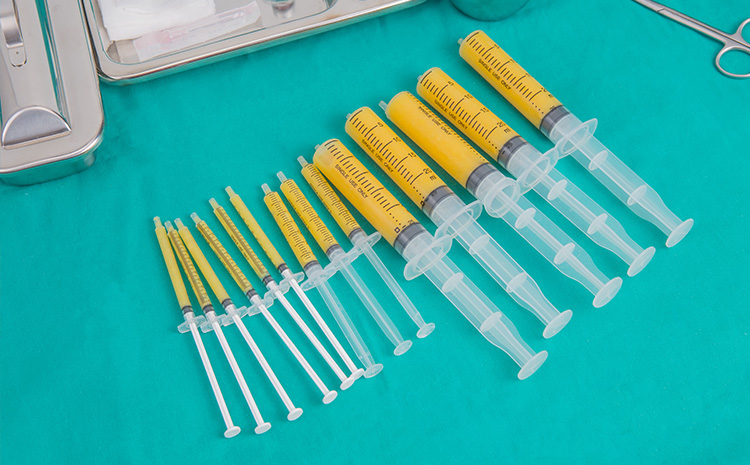
Breast Augmentation With Fat Grafting (Fat Transfer)
Also known as fat transfer, fat grafting to breasts is a procedure in which the breast is augmented by transferring fat from another body part, such as the abdomen or thighs, to the breasts.
Fat filtration
To perform fat grafting, fat must first be secured. Puregraft’s filtration technology aims to improve long-term graft retention through the use of superior fat. In a peer-reviewed article comparing Puregraft to centrifugation and the decanting method, Puregraft has consistently lower contaminant levels. With Puregraft technology, the microscopic appearance of fats shows significantly more purified and concentrated viable adipocytes. This system removes all unwanted fluids of the harvested fat with minimal trauma to the fat cells. After filtering, pure, viable, high quality and condensed fat will be ready for usage.

Fat grafting/ fat transfer surgery process
Tumescent fluid, which aims to control bleeding, is first injected into the fat donor site. The injection site is typically at the abdomen or thighs. After the fat gets syringed out through small cuts of less than 1cm, it is then processed. The usable fat gets injected under the skin of the breasts. Using multiple 1ml syringes, fat is injected in small aliquots (parcels) to ensure fat survival. This process makes sure that a large surface area for maximum diffusion of nutrients from the surrounding tissues. This is the science behind increasing the survival rate of fat cells. Typically, about 60% to 70% of the injected fat survive. In fact, the fat will contain a bit of your stem cells, which can help rejuvenate the skin. The entire procedure can take anywhere from 1.5hr – 3hrs.
Pre-requisites for using fat transfer in breast augmentation
The patient will need to have sufficient excess fat in order to enable fat grafting. Fat is often harvested from the tummy area, love handles, as well as the inner and outer thighs.
Fat graft with breast implants
To boost your breast implants, you can combine it with your own fats. Motiva Hybrid uses a combination of its Motiva Ergonomix implant as well as fat harvested from the patient’s body. The implant used will be smaller than what will typically be used, and the rest of the volume will be filled through fat grafting. These additional soft tissue padding cushions the margins and edges of your breast implant, thereby creating a natural look.
A software on the Crisalix imaging system helps plan the Motiva hybrid breast augmentation. By inputting your ideal bra cup size and current breast measurements, the system will determine the suggested breast implant volume and fat graft required for each breast.
Fat grafting does not lengthen the recovery period. Pain tends to be minimal, although swelling and bruising on the donor areas will be present. A Motiva hybrid breast augmentation can therefore be considered the ultimate and most premium of breast augmentation procedures.

Suitable Candidates for breast augmentation with fat transfer
Patients who prefer to use natural fat as opposed to depositing foreign items into their body may be interested in this procedure. However, more than one session of fat grafting will be required, and results are likely to be less dramatic and slower as compared to breast implants. This process can be helpful for those with a tuberous breast, widened cleavage after a breast implant surgery, or even mild breast deflation after breastfeeding.
The patient’s tissue is also another factor to consider. Every individual’s breast has its own unique limit depending on how much the skin can take. If too much fat is injected and the skin gets too tight, blood supply may be compromised and the fat cells may die as a result.
As such, good candidates of fat grafting will include patients who were previously pregnant and have breastfed. This would mean that their breast tissue has been expanded post-pregnancy. Using the same logic, women who have had their breast implants removed may also be great candidates for their breasts are expanded and should be able to accept the fats. Those who went through multiple capsular contractures with implants can also consider fat grafting as an alternative.
A word of caution
Fats transferred that died can cause small calcium deposits on the mammography. To prevent this, a skilled surgeon needs to employ meticulous injection techniques. Other fat transfer breast augmentation risks include, but are not limited to, cysts, infection, death of fat cells, possibility of transferred leaving the breast area, and more. Depending on your breast type, you may need to use a tissue expansion system a week prior to the surgery for better results. Touch up injections may also be needed in future to maintain the breast shape.
A misconception that some patients have is that fat injection may affect the risk of breast cancer. This is not true.
Things to note
There are limitations to how big the cup size can get with fat grafting. Typically, the procedure can only increase the cup size by half to one cup, which is approximately 75lm – 150ml. Asians typically have less fat, and can typically only up their cup size by 2/3 or one using their own fat. In the event that up to two cup sizes are wanted, using a breast implant may be a better option.
Even if there is enough fat to go up two cup sizes, the resultant breast shape may not be desirable.
Conclusion
Depending on your body type as well as how big you want your breasts to look, fat grafting can be something to consider. Having fat grafting performed on you after your breast implant surgery can also enhance the overall look and feel of your augmented breasts.
